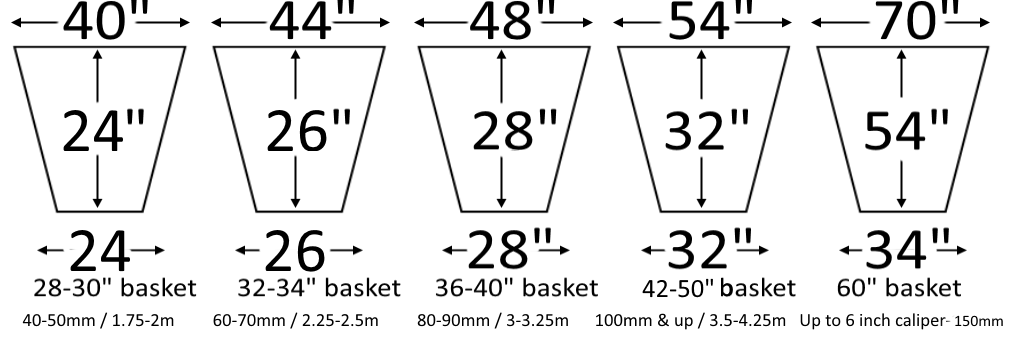

For basketed, field grown trees, here are the recommended hole sizes:

For potted plants, here are the recommended hole sizes:

Please note that these are based on average container sizes. You may need to make final adjustments at time of planting, as there are many variations of baskets and pots.
Be sure to not dig your hole too deep, and check out instructions on how to properly install plants here.
We have written an in depth walkthrough on how to care for your new plant - please click here to view our Plant Care Guide.
This guide goes over watering techniques for all 4 seasons, along with how to fertilize, and how to prune.
Please note that each site has different watering needs, meaning you may need to perform general moisture testing, and frequent observation of your plants to adjust watering habits. This is all discussed in our Plant Care Guide.
Do not water your plants during the winter, or during a Chinook, as water is warmer than the frozen ground, and could defrost the rootball prematurely. This could lead to the tree "waking up" early, and then freezing, which will likely cause your plant to perish.
We recommend a pellet form general 20-20-20 fertilizer, applied up to a maximum of twice per year. Please check out the Fertilizing section of our Plant Care Guide here.
20-20-20 fertilizer can be found on the shelf in most garden centers, and can be applied to any type of plant. Please always follow the instructions on the label.
50mm, 60mm etc.. is a unit of measure used for Deciduous trees. It is called caliper size or trunk size, which we record in millimeters. This caliper measurement is the width of the trunk at 4-6 inches (10-15cm) above soil level.
Heights of deciduous trees vary greatly from species to species, making height an invalid measure of the maturity of leafy trees. For example, a 50mm Ivory Silk Lilac tree may be between 6-8 feet tall, whereas the same 50mm Swedish Columnar Aspen may be between 12-15 feet tall. Both trees are close to the same age, and are harvested in similar sized baskets, but the heights vary wildly.
Contact us if you would like a height estimate on a given tree or plant. Also feel free to book a consult to come view the trees in person!
Please note that Evergreen trees are measured by height, as their height to age ratio is much more standard across varieties such as Spruce, Pine, Fir etc....
Here are the recommended hole sizes for each tree size size, to give you an idea how large each rootball is:

These are potted plant sizes. #1 means 1 gallon, #2 means 2 gallon and so on. You may see it written as 1g or 1gal or #1. It is a rough measurement of how big the plastic pot is.
As plants grow larger, they will be transplanted from smaller pots into larger pots. In order of smallest to largest, we generally work with #1, #2, #5, #7, #10, #15, and #20 pot sizes.
Here are the recommended hole sizes for each pot size, to give you an idea how large each pot is:

We have written in depth walkthroughs on how to plant basketed and potted plants - please click one of the following links:
Have many of the needles on your pine tree have been dropping off lately?
Don't worry and don't cut the tree down! There is a perfectly natural explanation.
Though pines and most other conifers are called evergreens, their needles do not stay alive and green forever. Generally, new needles are produced every spring and summer and last for two to four or more years. So, as the tree grows larger year-by-year, newer needles are always at branch ends and older needles are farther back in the crown.
As needles age, they become less efficient at producing food for the tree. They also become more shaded by newer needles. For these reasons, old needles finally turn brown and drop off. This doesn't hurt the tree because several year's worth of newer needles are always there to replace the old ones.
Do be concerned, however, if your tree is losing needles at the branch tips. These needles are young and have not out-lived their usefulness. The culprit is probably some type of disease or insect.
So, if one-third to one-fourth of the needles on the inner parts of your evergreen tree are falling off, it is probably just a normal sign of aging. Just rake up the dead needles, or better yet, leave them under the tree for a good mulch.
Potted items can be easily picked up by hand, and transported in almost any vehicle, but for field grown trees in baskets, you will need a pickup truck and/or trailer to transport it home. Once you are home, you will likley need machinery to unload it, or a compliment of able bodies (we recommend putting 2 metal breaker bars in the basket tabs and having 4 people lift it).
See some estimated weights below (please note these weights will increase during rainfall as extra water is absorbed by the soil):
We have a list of recommeneded landscapers we can send to you if interested in hiring out the transport and planting phase of the project. We also have some delivery options that can be found here, but for smaller quantities, it is usually more effective to contact a landscaper.
Please see below for some supplies that will help you get your plant home safely
It may take 2-4 years before your plant feels comfortable enough to produce fruits. Fruits require an enormous amount of energy and water to produce, and your plant may want to focus on root growth instead of fruit for the first few years. The tree may also decide to produce a smaller number of fruits, or the fruit may be very small. Please also note that most mature fruiting trees in Alberta do not have ready fruit until late in the season, so it could also be that the fruits are just very small when you checked.
Your tree goes through stress when it is moved and planted in it's new home. This is called Transplant Shock, and can manifest in many ways, including lack of fruit. Please check out our Plant Care Guide to learn more about Transplant Shock.
The short answer is no, do not stake your plants. More often than not, the stakes and ties around the trunk are forgotten, and will bite into the trunk as it grows, eventually killing the tree.
The long answer is yes but only if you think you need it (for example in a wet and windy site), but you must take care to do it properly, and remember to remove it. Due to the windy conditions in the Calgary area, and the large amounts of water that new plants need, it may be necessary to stake your trees. 2 general methods of staking trees exist: metal guy wires, and posts made out of wood, metal or bamboo. The tie around the trunk should leave a few inches for tree movement to prevent rubbing damage and encourage strong trunk development.
Stakes made from wood, metal or bamboo are our best recommendation if you are staking. Generally, the stake would be located on the side of the prevailing winds. In Calgary, this is usually the NW side. Drive the stake into the ground, but do not put it on top of the rootball. Tie the stake to the trunk of the plant with a soft flagging tape. Larger plants may require the use of metal wire instead of tape. Make sure you protect the trunk from the wire using some sort of long lasting buffer, such as a piece of thick rubber garden hose.
Metal guy wires can be used to secure larger trees - use the same method as above, but drive 3 metal stakes into the ground, at an angle away from the tree, not on top of the rootball. These should be equally spaced around the tree, in a triangle pattern. Punch your stakes 2/3 into the ground, with 1/3 exposed. Use metal wire to tie the trunk to these stakes, making sure to protect the trunk with a buffer piece, as explained above.